|
|
By Sandy, on January 31st, 2009
Hydroculture (a.k.a. passive hydroponics) is the practice of cultivating plants without the use of soil. Because of the ease of maintenance and its many other advantages over soil, it is a perfect way for indoor gardening.
So why is hydroculture so good?
Healthier
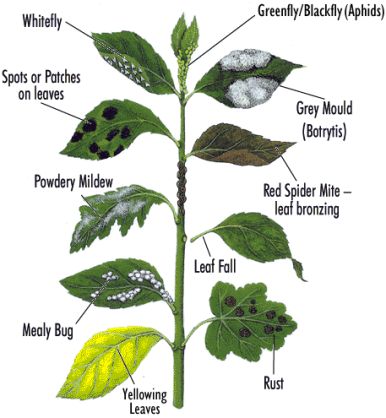
- Reduce allergy – no more spores, mold, mildew that are found in soil
- Pest free – no centipedes, sow bugs, worms or other soil pests
- Reduce odor
Continue reading Why is Hydroculture So Good?
By Sandy, on January 31st, 2009
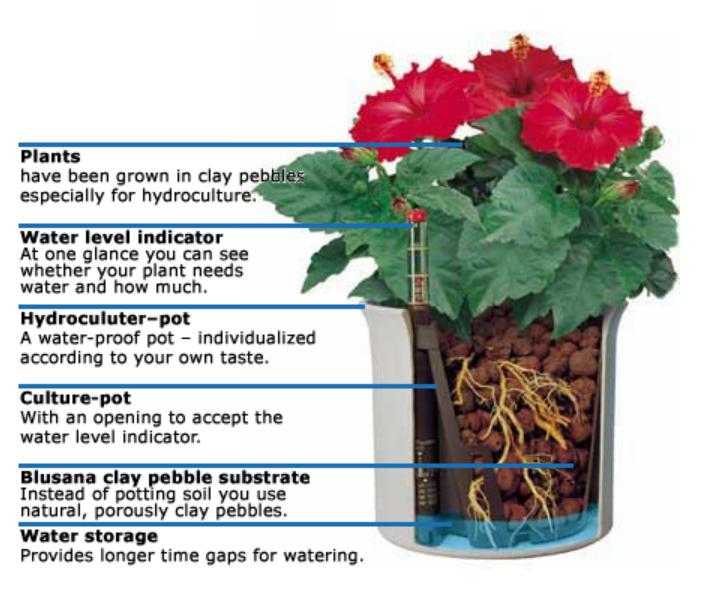 Here are the five main components of a hydroculture system. Here are the five main components of a hydroculture system.
Plant
Many houseplants can grow nicely in a hydrocultural environment.
Continue reading The 5 Components of Hydroculture Kit
By Sandy, on January 31st, 2009
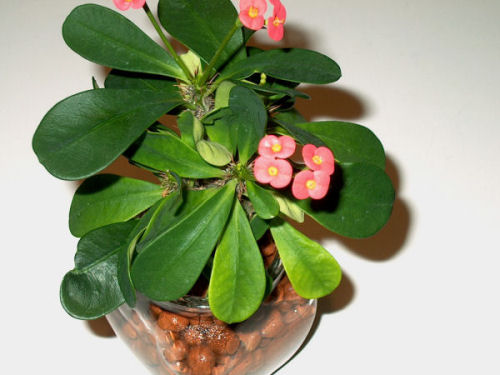 Sometimes, hydroculture is called the passive hydroponics. It is like the little brother of hydroponics – with smaller containers, simpler solution, and a cheaper and less complicated system. While hydroculture likes hydroponics, can be used for growing vegetables that we can buy in supermarkets, hydroculture is more for houseplants and for the fun of indoor gardening. Sometimes, hydroculture is called the passive hydroponics. It is like the little brother of hydroponics – with smaller containers, simpler solution, and a cheaper and less complicated system. While hydroculture likes hydroponics, can be used for growing vegetables that we can buy in supermarkets, hydroculture is more for houseplants and for the fun of indoor gardening.
Continue reading What is Hydroculture?
By Sandy, on January 31st, 2009
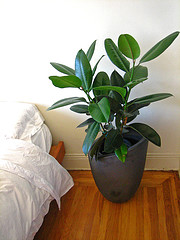 How long a plant lives in a water culture greatly depends on the water source. Water should keep fresh and nutritious, for plants need mineral nutrients to grow healthy. How long a plant lives in a water culture greatly depends on the water source. Water should keep fresh and nutritious, for plants need mineral nutrients to grow healthy.
When roots become deficient in mineral nutrients, particularly calcium and boron, which are required in the external solution for normal functioning of roots, the roots die and decay. Continue reading Watering Hydroculture Plants
By Sandy, on January 30th, 2009
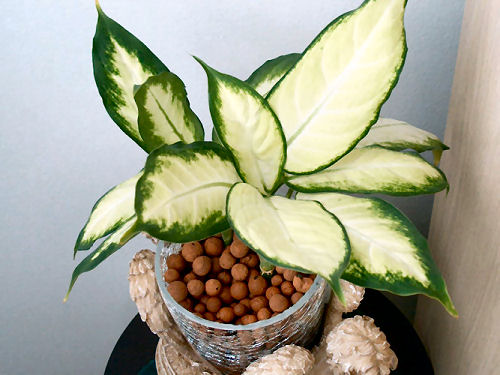 It was quite difficult when I first did my research online on this subject, for I couldn’t find what exactly it is called. It seems like that there is no one specific terminology for this type of plants. It was quite difficult when I first did my research online on this subject, for I couldn’t find what exactly it is called. It seems like that there is no one specific terminology for this type of plants.
Some call it “hydroculture.” However, instead of the plant itself, hydroculture is referring to a system, a simpler version of hydroponics, which involves the use of an inner pot, an outer pot, a water level indicator, and such.
Continue reading So what is it called? Hydroculture? Aquatic plants? Water roots?
By Sandy, on January 30th, 2009
Even though I have seen bamboo stick in a pot of pebbles filled with water, but it is only until recently, when I started to get my interest in indoor gardening and tabletop gardens, did I realize that plants actually don’t need soil to grow. Essentially the soil is just a medium for holding . . . → Read More: Hydroculture – Clean, Easy, and Simple!
By Sandy, on January 25th, 2009
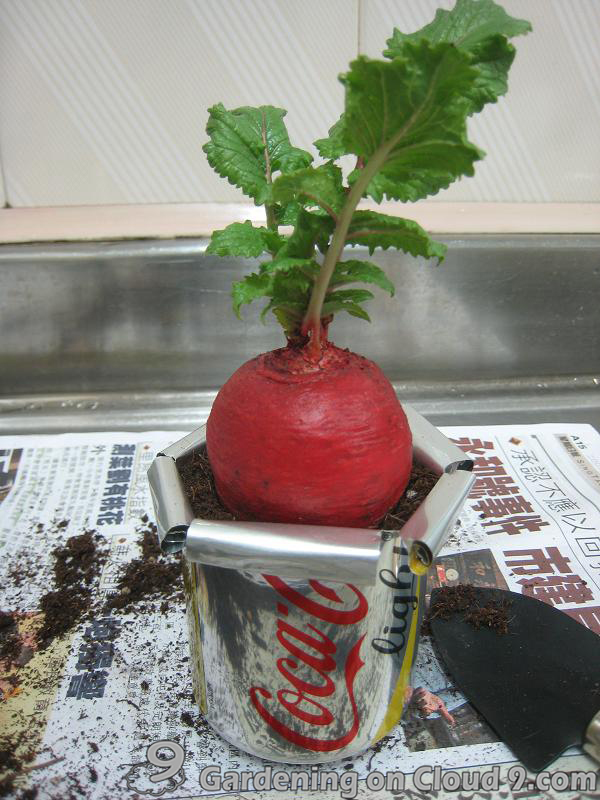
Almost anything can be used as a container in your garden…
Your imagination is your only limitation…
This has almost become a cliche for it can be heard from every gardener or read in every book of container gardening.
Yet, nevertheless, it’s so true. In fact, this is what make container gardening so much fun. We can just be creative and playful and use whatever material we have on hand to make containers into certain sizes, colors, functions that suit our specific needs and styles.
And yesterday, I tried to make a container with a soda can. I have especially chosen a can of coke light for I like how its silver and red match nicely with the little beet I bought earlier.
Here is how I made the soda can container. Continue reading How to Make Garden Container Using Soda Can
By Sandy, on January 22nd, 2009
Here are my top ten indoor gardening tips for gardening novices.
Tip 1 – Choose the Right Plant
Before you bring a houseplant into your house, you just have to make sure you can give what it needs to grow healthily. Choose only those plants that will be able to grow in the climate and condition of your room. Here is a list of suitable houseplants with photos for indoor gardening that you may find helpful.
Tip 2 – Enough Sunlight?
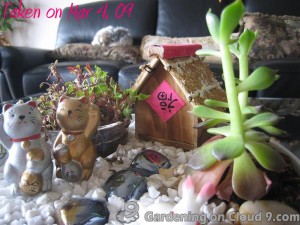 Like oxygen and water, plants need sunlight to grow healthily. If your house does not have a lot of sunlight, and if you are not planning to use any artificial light, don’t worry, for you still have many options to choose from. Different types of houseplant require different amount of sunlight. There are many types of plants that thrive in medium to low light conditions, such as African violets, Boston ferns, Spathiphyllum, Philodendrons, and many more. Like oxygen and water, plants need sunlight to grow healthily. If your house does not have a lot of sunlight, and if you are not planning to use any artificial light, don’t worry, for you still have many options to choose from. Different types of houseplant require different amount of sunlight. There are many types of plants that thrive in medium to low light conditions, such as African violets, Boston ferns, Spathiphyllum, Philodendrons, and many more.
Related Post about Light Requirements
My Echeveria is Growing Way Too Tall!
|
|


 Sometimes, hydroculture is called the passive hydroponics. It is like the little brother of hydroponics – with smaller containers, simpler solution, and a cheaper and less complicated system. While hydroculture likes hydroponics, can be used for growing vegetables that we can buy in supermarkets, hydroculture is more for houseplants and for the fun of indoor gardening.
Sometimes, hydroculture is called the passive hydroponics. It is like the little brother of hydroponics – with smaller containers, simpler solution, and a cheaper and less complicated system. While hydroculture likes hydroponics, can be used for growing vegetables that we can buy in supermarkets, hydroculture is more for houseplants and for the fun of indoor gardening. How long a plant lives in a water culture greatly depends on the water source. Water should keep fresh and nutritious, for plants need mineral nutrients to grow healthy.
How long a plant lives in a water culture greatly depends on the water source. Water should keep fresh and nutritious, for plants need mineral nutrients to grow healthy. It was quite difficult when I first did my research online on this subject, for I couldn’t find what exactly it is called. It seems like that there is no one specific terminology for this type of plants.
It was quite difficult when I first did my research online on this subject, for I couldn’t find what exactly it is called. It seems like that there is no one specific terminology for this type of plants.
 Like oxygen and water, plants need sunlight to grow healthily. If your house does not have a lot of sunlight, and if you are not planning to use any artificial light, don’t worry, for you still have many options to choose from. Different types of houseplant require different amount of sunlight. There are many types of plants that thrive in medium to low light conditions, such as African violets, Boston ferns, Spathiphyllum, Philodendrons, and many more.
Like oxygen and water, plants need sunlight to grow healthily. If your house does not have a lot of sunlight, and if you are not planning to use any artificial light, don’t worry, for you still have many options to choose from. Different types of houseplant require different amount of sunlight. There are many types of plants that thrive in medium to low light conditions, such as African violets, Boston ferns, Spathiphyllum, Philodendrons, and many more.
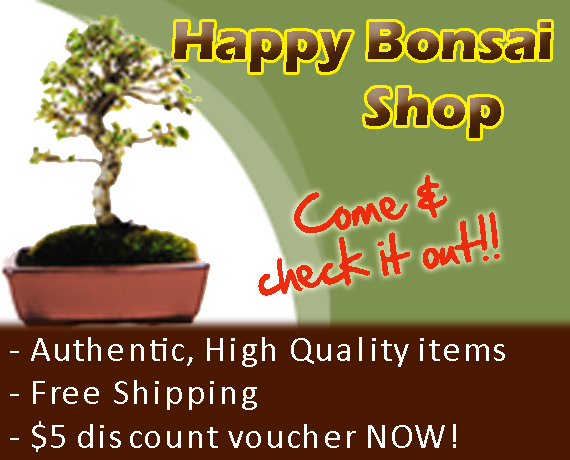

Recent Comments